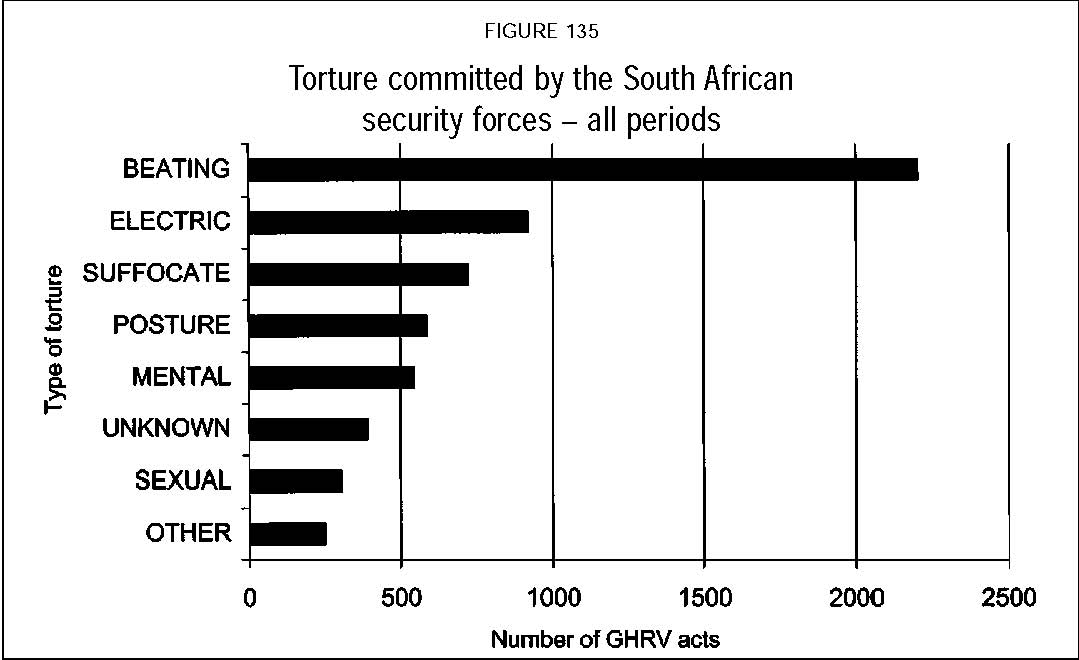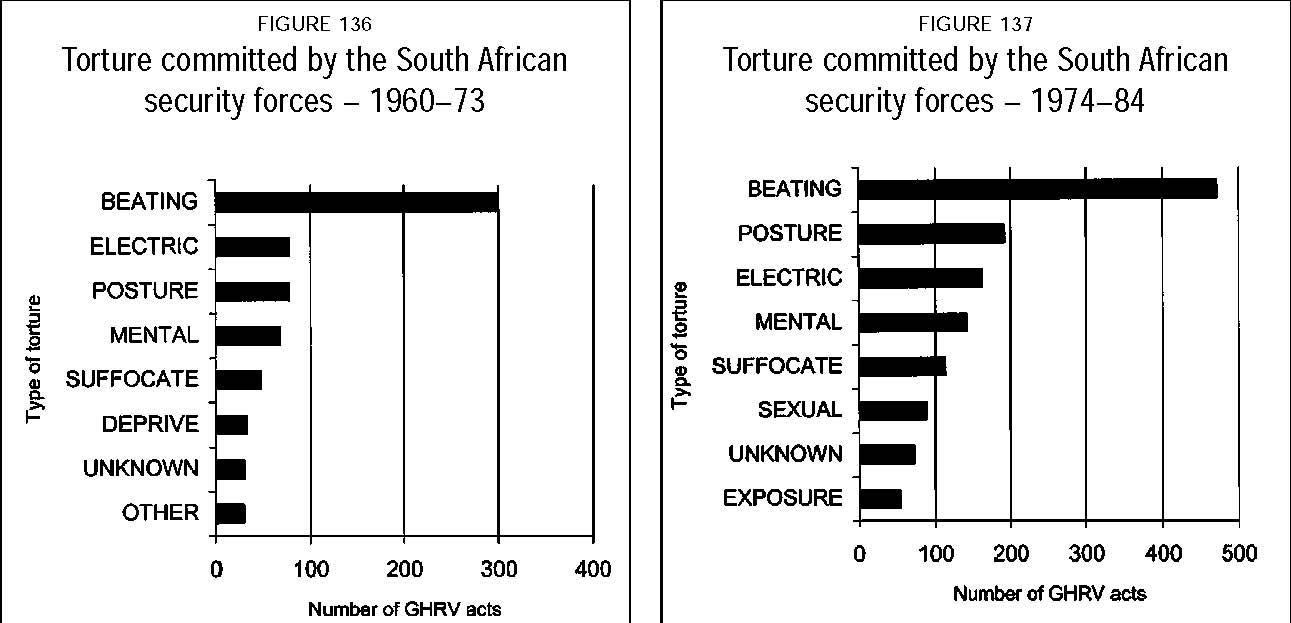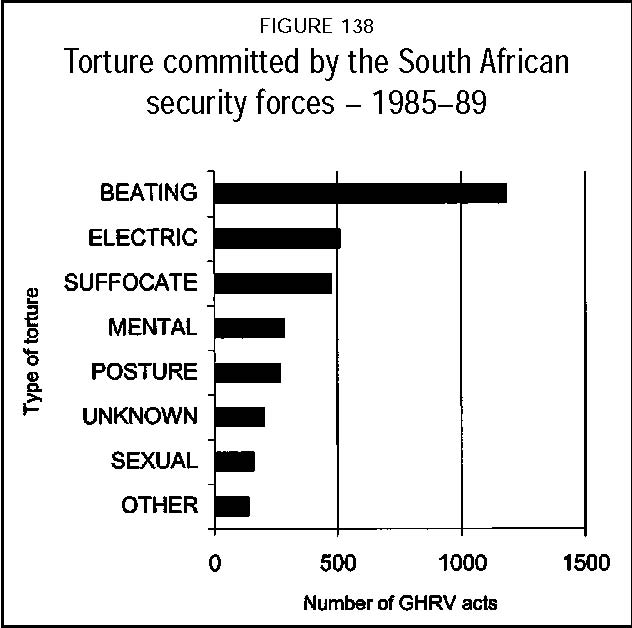 |
News | Sport | TV | Radio | Education | TV Licenses | Contact Us |
 |
News | Sport | TV | Radio | Education | TV Licenses | Contact Us |
TRC Final ReportPage Number (Original) 189 Paragraph Numbers 102 to 108 Volume 2 Chapter 3 Subsection 12 Methods of torture102 The Commission accepted the following internationally accepted definition of torture: The intentional infliction of severe pain and suffering, whether physical or mental, on a person for the purpose of (1) obtaining from that or another person information or a confession, or (2) punishing him for an act that he or a third person committed or is suspected of having committed, or (3) intimidating him or a third person, or (4) for any reason based on discrimination of any kind. Pain or suffering that arises only from, inherent in, or incidental to, a lawful sanction does not qualify as torture.8 103 The cases of torture presented to the Commission included a wide range of physical and psychological types. The following graphs indicate the extent to which different techniques of torture were used:  dth="319" height="195"> dth="319" height="195">  dth="381" height="184"> dth="381" height="184"> dth="187" height="185"> dth="187" height="185">104 Beating was the most commonly used form of torture. The Commission did not distinguish between beating detainees as a form of torture and what appears to have been a routine practice of beating and assault at the point of arrest. The latter was used to instil terror and to ‘soften people up’ before questioning and appears to have been widely and routinely used. This section, however, concentrates mainly on the use of torture to extract information or as a means of recruitment of informers. 105 A range of other techniques were regularly used. Suffocation as a form of torture increased significantly from 1975 to the end of the Commission’s mandate period, when it became the third most common form of torture. 106 Mr Rajeegopal Vandeyar [JB00809/01GTSOW] told the Commission of the torture he experienced while in the custody of the police: There were a number of policemen, some in uniform, some not, most visibly armed … They began assaulting me, kicking and punching me, hitting me with gun butts. The policemen were all involved in some way or another as I was beaten from ‘pillar to post’. At regular intervals I lost consciousness. They threw water on me to revive me. They kept asking me in derogatory terms – ie calling me “Coolie” … Lieutenant van Wyk and Rooi Rus Swanepoel were particularly [vicious] … A certain Major Brits was also present throughout, but did not lay a finger on me. He was in charge of the investigation. 107 Mr Ndovela Nxasana [EC0578/96ETK] was arrested in 1960 and kept at the Mkhambathi forest detention camp during the Pondoland uprising. He was one of the first people in the mandate period to describe electric shock torture. Mr Abdulhay Jassat [JB00184/01GTSOW] was also subjected to electric shocks while in police custody: A hessian bag was put over my head and … it was tied at my knees … They then lay me on the floor … they started … untying my shoes, shoelaces and removing my socks and I could feel them fiddling around with my big toes. Then I was told I had better start talking otherwise they were going to give me electric shock treatment … They would torture for about … thirty seconds to a minute. Then they would stop, ask you a question, when you refused to answer they would say we are increasing it … They went on until eventually they went up to 220 or 225 volts. Then they untied the electrodes from my toes and they lifted me up, removed the hessian bag and told me to stand on the floor without touching anything. I wasn’t able to stand. My body was completely stiff so I tried to lean against the table, and when I did that they came with a ruler or some instrument and just rapped me on my knuckles … 108 Former member of the Durban Riot Unit Sergeant Frank Bennetts [AM4059/96] described the technique from the torturer’s side during a section 29 hearing: I did make use of a shocking device … They were available from anyone at Telkom. I can go fetch you one now … It was an old crank telephone … and you’d take two wires – well, the best one was just two keys, I presume, was the best way to do it. Just a normal key with a hole in the top. Tie a key on to each wire. The guy’s got a hood over his head. Dangle them so that they touch the palms of his hands. When the first shock goes through his hands close and he can’t open them again. While you keep turning the handle, he can’t let go of it.8 Article 1(1), Convention Against Torture and Other Cruel, Inhuman, or Degrading Treatment or Punishment. |